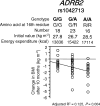Genetic basis of inter-individual variability in the effects of exercise on the alleviation of lifestyle-related diseases
- PMID: 19736300
- PMCID: PMC2805370
- DOI: 10.1113/jphysiol.2009.179283
Genetic basis of inter-individual variability in the effects of exercise on the alleviation of lifestyle-related diseases
Abstract
Habitual exercise training, including a high-intensity interval walking programme, improves cardiorespiratory fitness and alleviates lifestyle-related diseases, such as obesity, hypertension and dyslipidaemia. However, the extent of improvement has been shown to differ substantially among individuals for various exercise regimens. A body of literature has demonstrated that gene polymorphisms could account for the inter-individual variability in the improvement of risk factors for lifestyle-related diseases following exercise training. However, the fractions of the variability explained by the polymorphisms are small (5%). Also, it is likely that the effects of gene polymorphisms differ with exercise regimens and subject characteristics. These observations suggest the necessity for further studies to exhaustively identify such gene polymorphisms. More importantly, the physiological and molecular genetic mechanisms by which gene polymorphisms interact with exercise to influence the improvements of risk factors for lifestyle-related diseases differentially remain to be clarified. A better understanding of these issues should lead to more effective integration of exercise to optimize the treatment and management of individuals with lifestyle-related diseases.
Figures



Comment in
-
Inter-individual variability in the improvement of physiological risk factors for disease: gene polymorphisms or simply regression to the mean?J Physiol. 2010 Mar 15;588(Pt 6):1023-4; author reply 1025. doi: 10.1113/jphysiol.2010.187526. J Physiol. 2010. PMID: 20231148 Free PMC article. No abstract available.
Similar articles
-
The factors affecting adherence to a long-term interval walking training program in middle-aged and older people.J Appl Physiol (1985). 2015 Mar 1;118(5):595-603. doi: 10.1152/japplphysiol.00819.2014. Epub 2014 Dec 24. J Appl Physiol (1985). 2015. PMID: 25539937
-
High-Intensity Walking Time Is a Key Determinant to Increase Physical Fitness and Improve Health Outcomes After Interval Walking Training in Middle-Aged and Older People.Mayo Clin Proc. 2019 Dec;94(12):2415-2426. doi: 10.1016/j.mayocp.2019.04.039. Epub 2019 Aug 30. Mayo Clin Proc. 2019. PMID: 31477320
-
Cardiorespiratory fitness and heart rate recovery in obese premenopausal women.Scand J Med Sci Sports. 2012 Dec;22(6):e133-9. doi: 10.1111/j.1600-0838.2012.01522.x. Epub 2012 Sep 24. Scand J Med Sci Sports. 2012. PMID: 22998554 Clinical Trial.
-
[Exercise for prevention of osteoporosis and other lifestyle-related diseases].Clin Calcium. 2011 May;21(5):722-9. Clin Calcium. 2011. PMID: 21532123 Review. Japanese.
-
Low-intensity endurance exercise training, plasma lipoproteins and the risk of coronary heart disease.J Intern Med. 1994 Jul;236(1):7-22. doi: 10.1111/j.1365-2796.1994.tb01114.x. J Intern Med. 1994. PMID: 8021576 Review.
Cited by
-
The interaction between ABCA1 polymorphism and physical activity on the HDL-cholesterol levels in a Japanese population.J Lipid Res. 2020 Jan;61(1):86-94. doi: 10.1194/jlr.P091546. Epub 2019 Nov 6. J Lipid Res. 2020. PMID: 31694877 Free PMC article.
-
Inter-individual variability in the improvement of physiological risk factors for disease: gene polymorphisms or simply regression to the mean?J Physiol. 2010 Mar 15;588(Pt 6):1023-4; author reply 1025. doi: 10.1113/jphysiol.2010.187526. J Physiol. 2010. PMID: 20231148 Free PMC article. No abstract available.
-
Influence of Single-Nucleotide Polymorphisms in PPAR-δ, PPAR-γ, and PRKAA2 on the Changes in Anthropometric Indices and Blood Measurements through Exercise-Centered Lifestyle Intervention in Japanese Middle-Aged Men.Int J Mol Sci. 2018 Mar 1;19(3):703. doi: 10.3390/ijms19030703. Int J Mol Sci. 2018. PMID: 29494521 Free PMC article.
-
Comparing Time Efficiency of Sprint vs. High-Intensity Interval Training in Reducing Abdominal Visceral Fat in Obese Young Women: A Randomized, Controlled Trial.Front Physiol. 2018 Aug 3;9:1048. doi: 10.3389/fphys.2018.01048. eCollection 2018. Front Physiol. 2018. PMID: 30123136 Free PMC article.
-
Effect of exercise engagement and cardiovascular risk on neuronal injury.Alzheimers Dement. 2023 Oct;19(10):4454-4462. doi: 10.1002/alz.13400. Epub 2023 Aug 3. Alzheimers Dement. 2023. PMID: 37534906 Free PMC article.
References
-
- Andreasen CH, Stender-Petersen KL, Mogensen MS, Torekov SS, Wegner L, Andersen G, Nielsen AL, Albrechtsen A, Borch-Johnsen K, Rasmussen SS, Clausen JO, Sandbaek A, Lauritzen T, Hansen L, Jørgensen T, Pedersen O, Hansen T. Low physical activity accentuates the effect of the FTO rs9939609 polymorphism on body fat accumulation. Diabetes. 2008;57:95–101. - PubMed
-
- Bouchard C, Rankinen T. Individual differences in response to regular physical activity. Med Sci Sports Exerc. 2001;33:S446–S451. - PubMed
-
- Bray MS, Hagberg JM, Perusse L, Rankinen T, Roth SM, Wolfarth B, Bouchard C. The human gene map for performance and health-related fitness phenotypes: the 2006–2007 update. Med Sci Sports Exrc. 2009;41:35–73. - PubMed
-
- Corbalán MS, Marti A, Forga L, Martínez-González MA, Martínez JA. The 27Glu polymorphism of the β2-adrenergic receptor gene interacts with physical activity influencing obesity risk among female subjects. Clin Genet. 2002;61:305–307. - PubMed
-
- Danser AH, Schalekamp MA, Bax WA, Van Den Brink AM, Saxena PR, Riegger GA, Schunkert H. Angiotensin-converting enzyme in the human heart. Effect of the deletion/insertion polymorphism. Circulation. 1995;92:1387–1388. - PubMed
Publication types
MeSH terms
LinkOut - more resources
Full Text Sources
Medical

